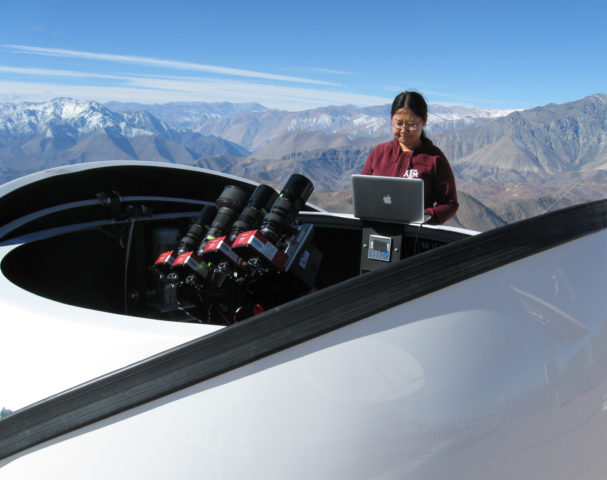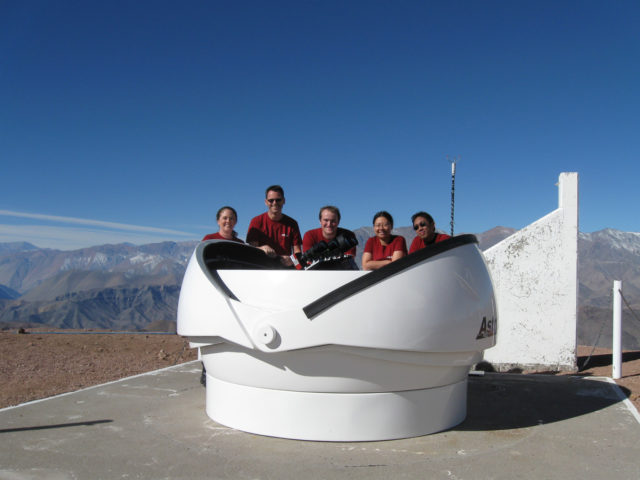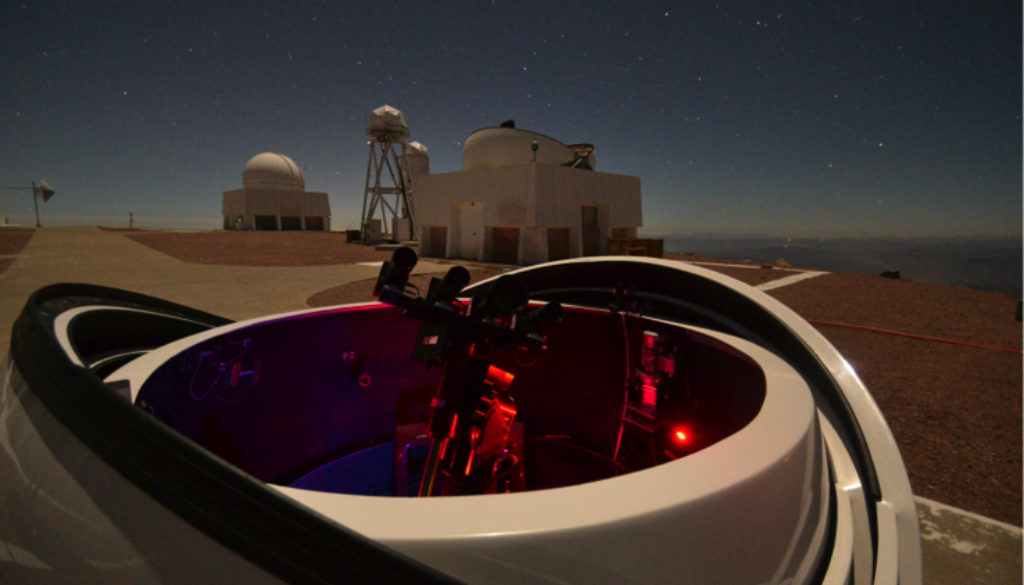Texas A&M Grad Student’s aTmCam Offers Cosmic Insight for Dark Energy Survey
As a child peering through her toy telescope, Texas A&M University graduate student Ting Li was fascinated by the Moon and constellations — not so much by their cosmic beauty, but about why they exist in the first place.
“The sky always seemed so beautiful to me,” Li said. “But outer space — that has always been a mystery.”
Now working toward her doctorate in astronomy as a member of Texas A&M’s Charles R. ’62 and Judith G. Munnerlyn Astronomical Laboratory, Li has developed her own instrument designed to help scientists understand more about the cosmos.
Li’s breakthrough device — dubbed the Atmospheric Transmission Monitoring Camera, or aTmCam — provides an innovative and efficient way of measuring subtle changes in the light that is constantly moving throughout the atmosphere. The resulting data will used by scientists as part of the Dark Energy Survey, a five-year investigation to understand the mysterious expansion of the universe.
Li’s aTmCam, located at the Cerro Tololo Inter-American Observatory in Chile, is housed in a mini-observatory that she and a Munnerlyn Lab team of undergraduate researchers hand-built. Completely computer-automated and operating on a script programmed by Li, the device is composed of a row of four high-power telescopes mounted with four charge-coupled device (CCD) cameras, each with a different filter.


On clear evenings, the mini-observatory’s seven-foot diameter dome opens, and aTmCam aims at a target star in the night sky. Each of its four cameras will capture a unique image of the wavelengths of light transmitted by the star. By observing specific features of the four images, Li can track changes in the atmosphere, providing preliminary data that DES scientists then will use to calibrate the photometry of Type Ia supernova — considered the best cosmological “standard candles” for measuring cosmic distances — taken as part of the survey.
“The scientific objectives of the Dark Energy Survey require measurements of the brightness of stars and galaxies with unprecedented precision,” said Texas A&M astronomer Darren DePoy, director of the Munnerlyn Lab and himself the project scientist for the world’s largest digital camera, the 570-megapixel Dark Energy Camera (DECam). “The Earth’s atmosphere absorbs, scatters and otherwise compromises such measurements. Fortunately, Ting’s approach removes one of the worst offending effects — the variability of the transmission of light through the atmosphere with time — in a robust manner. The added precision allows for significantly better distance determinations, which in turn substantially improves our ability to measure the effects of dark energy on the universe.”
As it stands, Li’s aTmCam will be in operation at least for the duration of the survey, but she believes it could have a much longer shelf-life, not to mention broader appeal. For starters, any researchers interested in observing variable stars and exoplanets may find aTmCam useful in determining if any irregularities are due to the star itself or to the atmosphere.
“In general, anyone interested in precision photometry can find use for aTmCam,” Li said. “Earth’s atmosphere is constantly changing, and this will ensure the most precise measurements are taken.”
Thanks in part to the precision science and astronomical instrumentation expertise represented within the Munnerlyn Lab and the George P. and Cynthia Woods Mitchell Institute for Fundamental Physics and Astronomy, Texas A&M has a key role in several major astronomical ventures across the world. Perhaps the most colossal is the Giant Magellan Telescope project, an 11-partner international collaboration working to construct the world’s largest telescope in Chile by 2019. The next-generation wonder features seven massive honeycomb mirrors and an adaptable optics system that hinges on state-of-the-art astronomical instrumentation, including first-light instruments being built at Texas A&M.
In 2010, Texas A&M astronomers were tasked with building the world’s premier survey spectrograph, the Visible Integral-Field Replicable Unit Spectrographs (VIRUS), a key component in the National Science Foundation-funded Hobby-Eberly Telescope Dark Energy Experiment (HETDEX), one of the first international efforts to probe and understand dark energy.
Beyond high-profile global partnerships, the Munnerlyn Lab’s broader astronomical contribution is in training future astronomers — undergraduate and graduate students like Li who have had direct involvement in the construction of the instrumentation and the resulting accumulation of data.
“We’ve done other small projects for the Dark Energy Survey in the past, but this is yet another example of the excellent work our undergrad and grad students are doing in our lab,” said Jennifer Marshall, associate research scientist in the Department of Physics and Astronomy and manager of the Munnerlyn Lab. “I think this is Texas A&M’s greatest contribution to this project and what makes me the most proud.”
For Li, it’s the culmination of a three-year process of constructing prototypes and test runs that involved multiple trips to Chile, often in extreme conditions. On more than one occasion, Li endured the high altitude’s freezing temperatures for hours at a time while making sure aTmCam ran properly.
“It’s amazing to have a working observatory at one of the best sites in Chile, if not the world,” Li said. “After all that we’ve been through in that short timeframe, everything is finished and working.”
Click here to see additional images of aTmCam and Li’s adventures in Chile.
To learn more about the Munnerlyn Astronomical Laboratory and related projects, visit http://instrumentation.tamu.edu.
For more information on Texas A&M astronomy, go to http://astronomy.tamu.edu.
# # # # # # # # # #
About Texas A&M Impacts: Texas A&M Impacts is an ongoing series highlighting the significant contributions of Texas A&M University students, faculty, staff and former students to their community, state, nation and world.
About Research at Texas A&M University: As one of the world’s leading research institutions, Texas A&M is in the vanguard in making significant contributions to the storehouse of knowledge, including that of science and technology. Research conducted at Texas A&M represents annual expenditures of more than $820 million. That research creates new knowledge that provides basic, fundamental and applied contributions resulting in many cases in economic benefits to the state, nation and world. To learn more, visit http://research.tamu.edu.
-aTm-
Contact: Chris Jarvis, (979) 845-7246 or cjarvis@science.tamu.edu or Dr. Jennifer Marshall, (979) 862-2782 or marshall@physics.tamu.edu
The post Texas A&M Grad Student’s aTmCam Offers Cosmic Insight for Dark Energy Survey appeared first on Texas A&M College of Science
